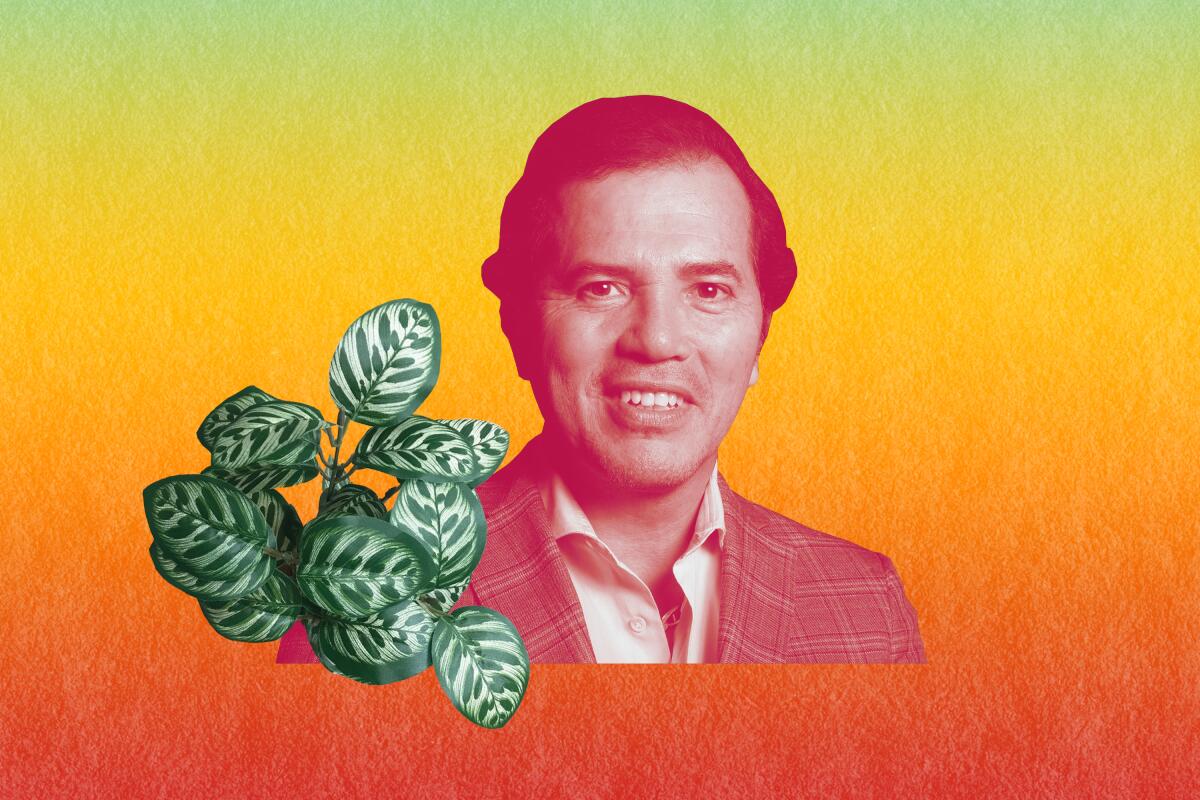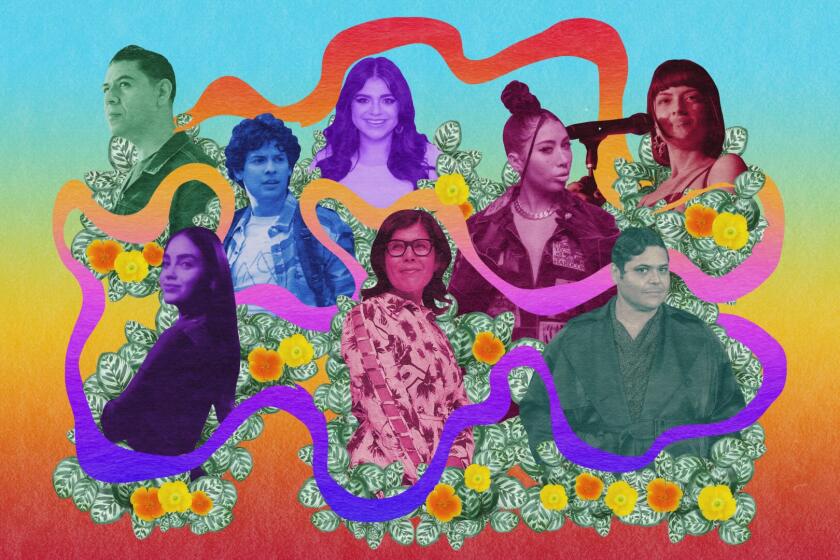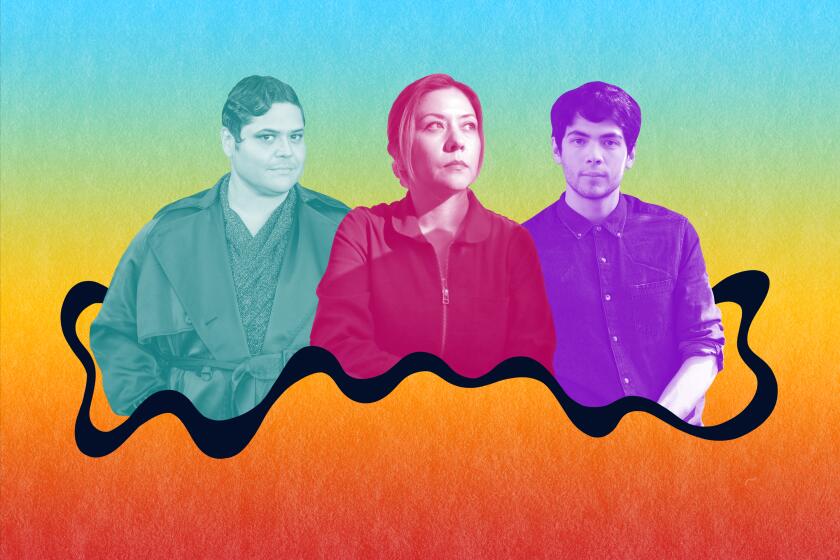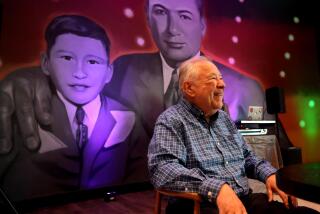John Leguizamo’s open letter to Hollywood

- Share via
You can be as talented as Marlon Brando or Ingrid Bergman, you can write like William Shakespeare or Arthur Miller, you can have the screen presence of Ryan Gosling or Jennifer Lawrence. But if you look Latino, or if you have a Latino last name, the odds are against you in Hollywood.
And by Latino, I mean born in Latin America. Not Spain, nor anywhere else in Europe. Those are white peoples. We Latinos are 19% of the population and the largest ethnic group in America, and we’ve been here long before the conquests of the 1500s. How are we not more visible onscreen and onstage? If much of the United States was Mexico until the 1840s or later, how are we not more visible?
Mexicans in East L.A. would sign up to be extras in westerns at the “casting tree” from 1910 until the 1930s. They were put in the background of a genre of film that was an appropriation of Mexican culture. The words were all Spanish: “Cowboy” comes from the Spanish word vaquero. Lassos, rodeos, broncos, corrals, ranches, the chaps, the hats are all parts of Mexican culture. The 10-gallon hat comes from the Spanish phrase tan galan. No cowboy hats were being worn in England, Ireland, Germany or the 13 colonies. But they were worn in Mexico. And yet, who were the leads in the westerns?
We need a better pipeline for Latinos in movies, TV shows and plays. We need a system for our stories and our projects. We need executives to provide the greenlight.
Our inaugural LA Vanguardia class is an amazing array of Latino talent shaping the movies, TV, music, fine arts and literary scene of today — and tomorrow.
If you take a big white movie and make it a Latin movie, it’s a hit. Take the new “Top Gun” and recast it with all Latin people, that’s a hit. Take a show like “Succession” and make all the characters Latin, that’s a hit. The remedies are there, but you have to be willing to put us on. As it stands right now, if your name is Garcia, Perez or Hernandez, and if you look Latino, you won’t get the same shot.
I’m not talking about white or white-passing Latinos. I mean Indigenous Latinos. I mean Aztec, Maya, Inca or Taíno. I mean Afro-Latino or any mix thereof. More often than not, the Latinos you see onscreen are white or white-passing — because Hollywood is drenched in colorism.
Can you imagine an Indigenous-looking Latino starring in “A Streetcar Named Desire”? Can you imagine an Afro-Latino as the lead in “Risky Business”? Even if that had happened, studio executives would have written off success with something like: “It was a one-off!” “This was a fluke!” “An aberration!” For Latinos, lightning never strikes twice.
For the record:
12:14 p.m. Nov. 3, 2022An earlier version of this article stated that Marlon Brando portrayed Emiliano Zapata in a film from the ’60s. The film, “Viva Zapata!,” is from 1952.
Even white Latinos are still stigmatized by their names and their culture. Óscar Isaac Hernández Estrada still goes by Oscar Isaac. Bruno Mars ditched his Hernandez. And while our actors can’t be cast, our stories are still co-opted. Mexican revolutionary Emiliano Zapata was played by Brando in the ’50s with full brownface and widened nostrils. Eli Wallach did brownface as a Mexican in “The Good, the Bad and the Ugly” as Tuco — a snarling and disgusting lowlife — to cater to how the studio executives thought a Mexican would act. In “Touch of Evil,” Orson Welles cast the whitest actor ever, Charlton Heston, as a Mexican. A light-haired, blue-eyed man playing a Latino in brownface with hair dyed black and a fake mustache. Again, real Latinos were merely set dressing — extras in the Mexican border town.
It didn’t stop there. You had Al Pacino in tan makeup, coked up and wild as a Cuban in “Scarface.” The studios loved it so much they put him in “Carlito’s Way” as a Puerto Rican from Spanish Harlem. They surrounded him with Latino actors, but not one of us had a lead role. In our own stories, we were still just supporting players.
Then there was Antonio Banderas in “El Mariachi,” Marisa Tomei in “The Perez Family,” Ben Affleck as CIA operative Tony Mendez in “Argo,” John Turturro as the bowler Jesus in “The Big Lebowski,” Javier Bardem in “Before Night Falls” and “Being the Ricardos” ...
Meet the inaugural LA Vanguardia class, talented Latinos defining the cultural landscape of L.A. and beyond.
Now, while we’re talking about it: Spaniards are not Latinos. Spaniards are white Europeans. Latinos were born in Latin America or had ancestors who were born there. For the most part, we are mixed-race peoples from all across Latin America. Well, all of Latin America except Argentina, which largely eradicated its Indigenous people. So there! I’ve broken it all down for you.
When Shakespeare was writing plays, men played the women’s parts. When women were finally allowed to act, the experience became so much more authentic for the actors and the audience. In a perfect world, everyone should be able to play any role. But Latinos rarely get cast, even in our own stories. So what may seem like a singular instance of casting a white actor is actually part of a deeper chasm of opportunity across generations.
The industry also doesn’t have enough Latino executives, or development heads or directors or writers. I have been pitching Latin stories featuring Latin heroes and Latin success stories, and executives say, “We loved it!” or “We need more stories like this!” or “The change starts with us!” But guess what happens? They never greenlight the project.
I have pitched for 40 years and I’ve spoken to other Latinx creators who know how impossible it has been to get anything put into the development pipeline, and that’s the secret sauce — having scripts in development until they are great. Because storytelling is king. But I do have to hand it to the studio heads and entertainment executives. They’re never without excuses, which range from the small-minded (“Latin movies don’t perform well”) to the ludicrous (“Latin people don’t wanna see Latin people in movies”) to flat-out false (“Latin people don’t go to feel-good movies,” and “Latin people are happy seeing white movies!”)
All of these excuses boil down to the simple fact that the big decision-makers do not care. They will profit no matter what, so why change the system? The fact is that Latinx audiences do support Latinx content. In 2021, Latinx ticket buyers made up 57% of opening weekend sales for “Encanto” and 40% of sales for “In the Heights.” We show up! And not just to the theater. We are streaming in big numbers too. Last year, Latinxs embraced diverse content in the family, animated, horror and fantasy genres. And because we skew young, we make up a huge audience for tween and YA content. So where are our coming-of-age stories?
When you walk anywhere in Los Angeles (except those gated communities), you see Latinos everywhere. That’s because the city is approaching 50% Latino. But where are we onscreen? That is cultural apartheid. The Latino population is larger than the white population in California, and yet we are not represented accordingly. That is cultural apartheid. In New York, the Latino population is equal to the white population, but you would never know it if you watched local TV or read our newspapers and magazines. The metrics are on our side, but the system is not.
When the system is driven by executives’ ideas, tastes or opinions, we are shut out. But when we are allowed to connect to our audience without a middle man, we win! That’s why Latino musical artists are killing it. Everything boils down to listens. The numbers never lie, and executives have no choice but to follow what’s popular. That’s why Bad Bunny is the No. 1 star in the world. And we have Top 10 talent in Cardi B (Dominican), Camila Cabello (Cuban), J Balvin (Colombian), Becky G (Mexican), Karol G (Colombian) and Kali Uchis (Colombian). We crush in baseball because of statistics, and we soar in politics because of votes.
When I was first starting out, I couldn’t get the lead because Hollywood would not cast me as the hero, the lawyer, the head of the department or the male love interest. If white people are 59% of the American population, why do they seem to get 120% of the casting, crew and executive team? We are a mere 2.9% of the leads in TV, movies, streaming and stage productions, according to the nonprofit Latino Donor Collaborative’s Latinos in Media Report.
There’s a fix for this: Cast more Latinos! We are nearly 20% of the population, so for every 10 characters, two should be Latino. For every 10 executives, two should be Latino. For every 10 crew members, two should be Latino. For every 10 films, two should be about Latinos.
You may think Lin-Manuel Miranda, Bad Bunny, J Lo, Benicio del Toro and I are the only ones, but you are wrong. There are millions of Latinos, and we were just among the few to be allowed through. Moving forward we all need to be counted, represented and valued.
More to Read
The biggest entertainment stories
Get our big stories about Hollywood, film, television, music, arts, culture and more right in your inbox as soon as they publish.
You may occasionally receive promotional content from the Los Angeles Times.












